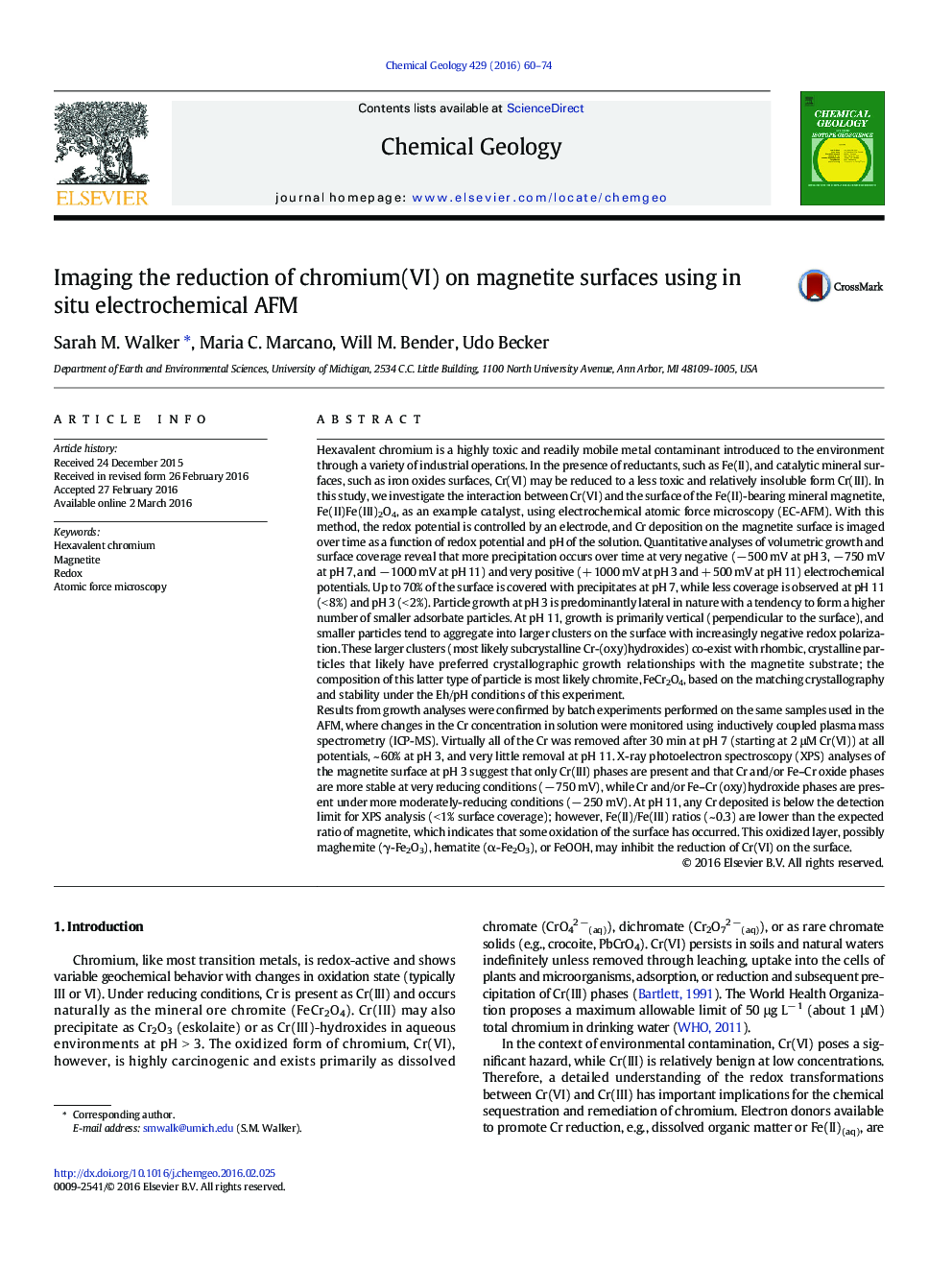| کد مقاله | کد نشریه | سال انتشار | مقاله انگلیسی | نسخه تمام متن |
|---|---|---|---|---|
| 6436106 | 1637545 | 2016 | 15 صفحه PDF | دانلود رایگان |

- Altering redox potential and pH conditions strongly affects chromium precipitation on magnetite surfaces.
- Growth at pHÂ 3 occurs at very reducing and very oxidizing conditions and is primarily lateral (i.e., parallel to the surface).
- While some growth is observed at pHÂ 11, oxidation of the mineral surface impedes Cr sorption at pHÂ 11.
Hexavalent chromium is a highly toxic and readily mobile metal contaminant introduced to the environment through a variety of industrial operations. In the presence of reductants, such as Fe(II), and catalytic mineral surfaces, such as iron oxides surfaces, Cr(VI) may be reduced to a less toxic and relatively insoluble form Cr(III). In this study, we investigate the interaction between Cr(VI) and the surface of the Fe(II)-bearing mineral magnetite, Fe(II)Fe(III)2O4, as an example catalyst, using electrochemical atomic force microscopy (EC-AFM). With this method, the redox potential is controlled by an electrode, and Cr deposition on the magnetite surface is imaged over time as a function of redox potential and pH of the solution. Quantitative analyses of volumetric growth and surface coverage reveal that more precipitation occurs over time at very negative (â 500 mV at pH 3, â 750 mV at pH 7, and â 1000 mV at pH 11) and very positive (+ 1000 mV at pH 3 and + 500 mV at pH 11) electrochemical potentials. Up to 70% of the surface is covered with precipitates at pH 7, while less coverage is observed at pH 11 (< 8%) and pH 3 (< 2%). Particle growth at pH 3 is predominantly lateral in nature with a tendency to form a higher number of smaller adsorbate particles. At pH 11, growth is primarily vertical (perpendicular to the surface), and smaller particles tend to aggregate into larger clusters on the surface with increasingly negative redox polarization. These larger clusters (most likely subcrystalline Cr-(oxy)hydroxides) co-exist with rhombic, crystalline particles that likely have preferred crystallographic growth relationships with the magnetite substrate; the composition of this latter type of particle is most likely chromite, FeCr2O4, based on the matching crystallography and stability under the Eh/pH conditions of this experiment.Results from growth analyses were confirmed by batch experiments performed on the same samples used in the AFM, where changes in the Cr concentration in solution were monitored using inductively coupled plasma mass spectrometry (ICP-MS). Virtually all of the Cr was removed after 30 min at pH 7 (starting at 2 μM Cr(VI)) at all potentials, ~ 60% at pH 3, and very little removal at pH 11. X-ray photoelectron spectroscopy (XPS) analyses of the magnetite surface at pH 3 suggest that only Cr(III) phases are present and that Cr and/or Fe-Cr oxide phases are more stable at very reducing conditions (â 750 mV), while Cr and/or Fe-Cr (oxy)hydroxide phases are present under more moderately-reducing conditions (â 250 mV). At pH 11, any Cr deposited is below the detection limit for XPS analysis (< 1% surface coverage); however, Fe(II)/Fe(III) ratios (~ 0.3) are lower than the expected ratio of magnetite, which indicates that some oxidation of the surface has occurred. This oxidized layer, possibly maghemite (γ-Fe2O3), hematite (α-Fe2O3), or FeOOH, may inhibit the reduction of Cr(VI) on the surface.
Journal: Chemical Geology - Volume 429, 1 July 2016, Pages 60-74